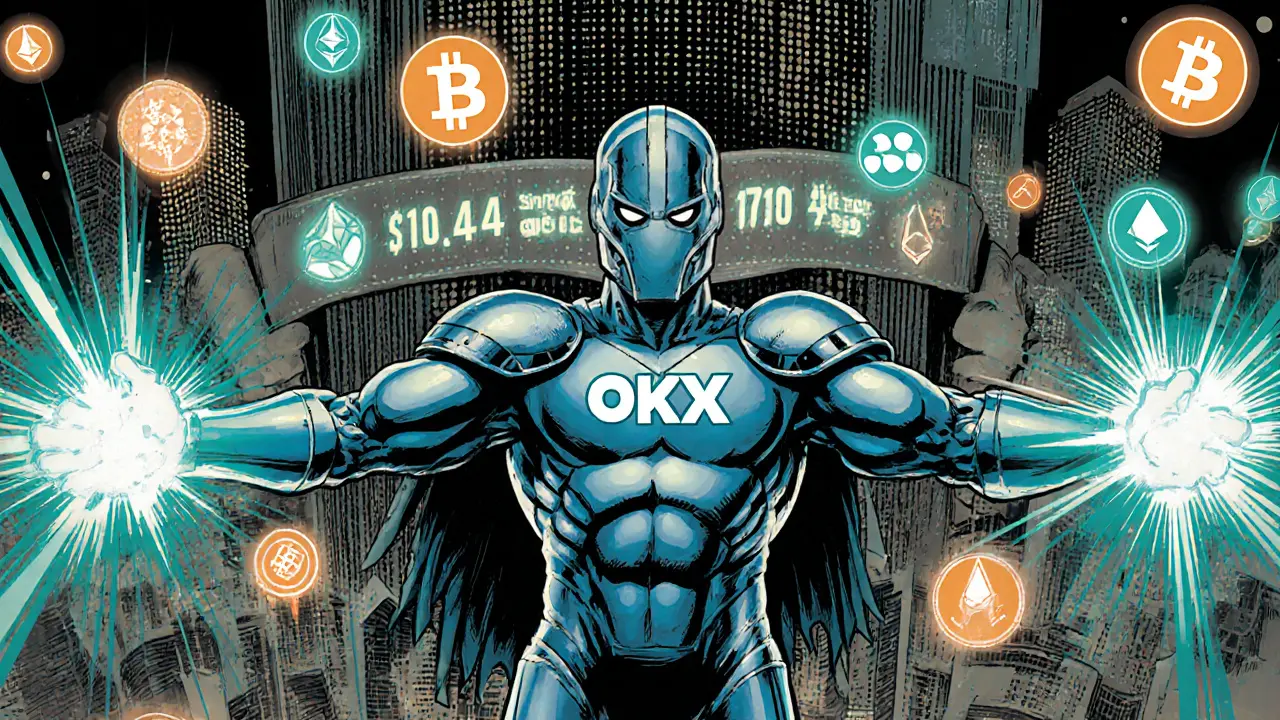
OKX Fee Calculator
Estimate Your OKX Trading Costs
Enter your trading details below to calculate potential fees for spot and futures trading.
Estimated Monthly Fees
TL;DR
- OKX is the 4th‑largest crypto exchange, handling $1.44bn daily volume.
- Fees range from 0.08%‑0.10% for spot trades; futures cost 0.03%‑0.05%.
- Supports 400+ tokens, 739 pairs, spot, margin, futures, options and DeFi.
- Security includes 2FA, anti‑phishing codes, cold‑storage and 100% BTC reserve.
- Pros: low fees, rich product suite, strong mobile app. Cons: limited regulator protection and occasional support delays.
What is OKX?
OKX is a Seychelles‑registered cryptocurrency exchange launched in 2017 by Star Xu. It now ranks as the fourth‑largest exchange by daily volume, processing about $1.44billion each day and serving users in more than 100 countries.
Core fee structure
The platform advertises a tiered maker‑taker model. Standard spot taker fees sit at 0.10% while makers pay 0.08%. High‑volume traders can dip to 0.02% maker rates after crossing $10million in 30‑day volume. Futures contracts carry lower rates-0.03% taker and 0.02% maker-reflecting the market‑making incentives built into perpetual swaps.
Deposit fees are nil for crypto; fiat deposits via bank transfer or credit card incur a 1.5%‑2% markup, depending on the currency. Withdrawal fees follow a flat‑rate schedule (e.g., $5 for Bitcoin, $2 for Ethereum) and are capped to keep costs predictable for small‑scale traders.
Product suite: spot, margin, futures & beyond
Spot Trading lets users buy or sell cryptocurrencies for immediate settlement. OKX lists over 400 tokens and 739 trading pairs, ranging from Bitcoin to newer meme coins.
For leveraged exposure, the exchange offers Margin Trading with up to 10x leverage on major pairs. Risk controls include real‑time liquidation alerts and adjustable maintenance margins.
Futures Trading covers quarterly contracts, perpetual swaps and options on BTC, ETH and a handful of altcoins. Traders can choose from 0.01‑100x leverage, and the platform provides an insurance fund of $700million to cushion extreme market moves.
The DeFi Hub integrates staking, liquidity mining and yield‑generating products directly within the exchange interface. Users can earn up to 12% APY on select assets without leaving OKX.

Security and regulatory outlook
Security is built on multiple layers. Every login requires Two‑Factor Authentication (2FA) via authenticator apps or SMS, and advanced users can enable anti‑phishing codes that appear on withdrawal screens.
Cold storage holds roughly 95% of user funds, while the remaining balance stays in hot wallets for instant withdrawals. OKX also publishes a proof‑of‑reserves audit showing a 100% reserve backing for Bitcoin, a claim that appeals to “not your keys, not your crypto” purists.
Regulatory coverage spans licences in Seychelles, UAE, Australia, Europe, Brazil, Singapore and the Netherlands. However, the exchange is barred in the United States, Canada, Japan, France, India and several other jurisdictions, limiting formal consumer protection in those markets.
Mobile and desktop experience
The Android app holds a 4.4/5 rating and the iOS version 4.6/5, reflecting a polished UI that mirrors the desktop layout. Users praise the unified navigation bar that toggles between Spot, Earn, Futures and Bot sections with a single tap.
Advanced charting tools include order‑book heatmaps, multi‑time‑frame candlesticks and built‑in indicators. Beginners benefit from a demo account that simulates live market conditions without risking real funds.
How does OKX stack up against Binance?
| Feature | OKX | Binance |
|---|---|---|
| Daily volume | $1.44bn | $3.21bn |
| Spot taker fee | 0.10% | 0.10% |
| Futures taker fee | 0.03% | 0.02% |
| Number of tokens | 400+ | 600+ |
| Regulatory licences | 7 (incl. EU, SG) | 5 (incl. Malta, US) |
| Risk fund | $700M | $1.2B (SAFU) |
| Mobile rating | 4.4/5 (Android), 4.6/5 (iOS) | 4.3/5 (Android), 4.5/5 (iOS) |
Both platforms excel in fee competitiveness and product depth, but Binance still leads in volume and token breadth. OKX’s edge lies in its Bitcoin‑centric reserve model and a slightly higher mobile app rating.
Pros and cons
- Pros: Low fees, extensive futures & options, 100% BTC reserve, robust mobile app, $700M risk fund.
- Cons: No regulated protection in many key markets, occasional deposit delays, support response times can be slow.
Bottom line
If you’re after a low‑fee, feature‑rich exchange that balances spot, leveraged and DeFi products, OKX deserves a serious look. The platform’s strong security posture and Bitcoin reserve give peace of mind, while the still‑growing customer‑service team may require patience during peak periods. For traders focused on Bitcoin or who need a reliable demo environment, OKX often outperforms larger rivals on cost and usability.
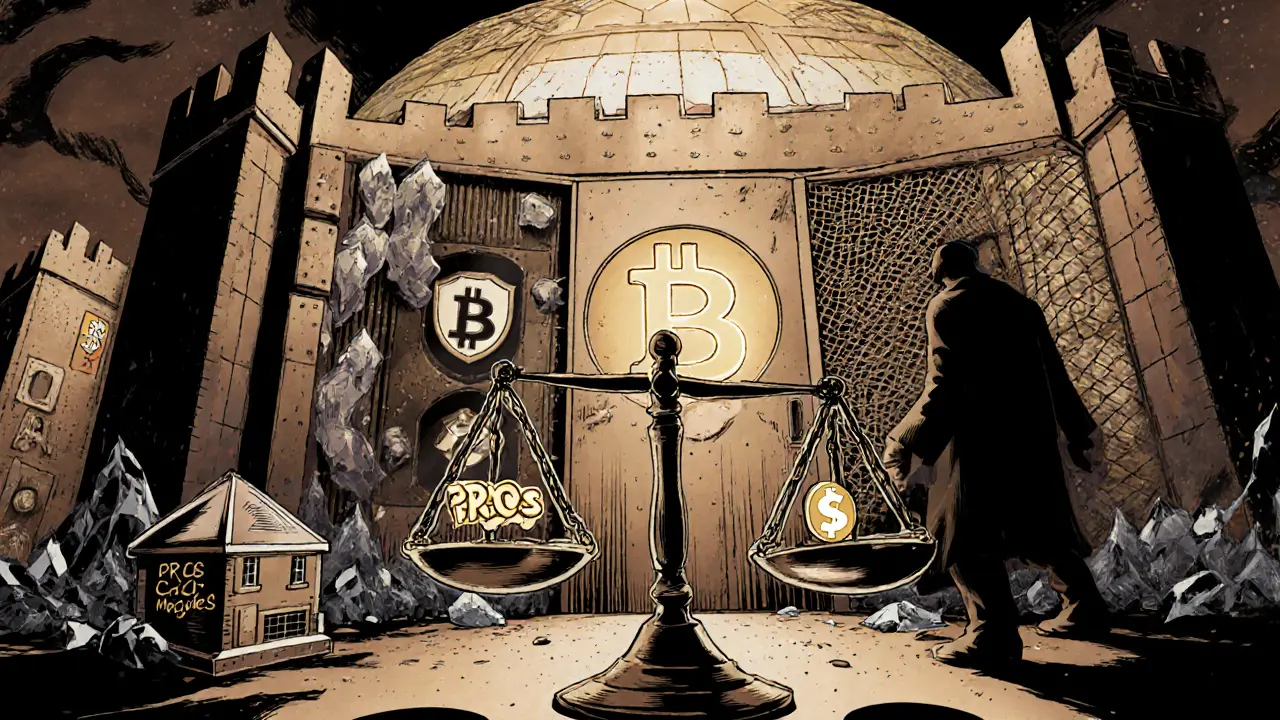
Frequently Asked Questions
Is OKX safe for large withdrawals?
Yes. OKX stores most assets in cold storage, requires 2FA and anti‑phishing codes for withdrawals, and backs Bitcoin 100% with reserves. Large withdrawals may trigger additional verification, but the process is standard across major exchanges.
Can I trade futures without a margin account?
Futures on OKX are settled on a separate margin system. You can open a futures position directly, but the platform will automatically allocate margin from your futures wallet.
What fiat currencies are supported for deposits?
OKX accepts USD, EUR, GBP, AUD, BRL, AED, SGD, CAD and JPY for fiat‑to‑crypto purchases.
How does the OKX risk fund work?
The $700million risk fund acts as a collateral pool that can be tapped to cover extreme market events or liquidation shortfalls. It’s managed by the exchange’s risk team and is only used in extraordinary circumstances.
Is there a demo account for beginners?
Yes. OKX offers a risk‑free demo environment that mirrors live market data, allowing new users to test spot, futures and bot strategies without risking real funds.

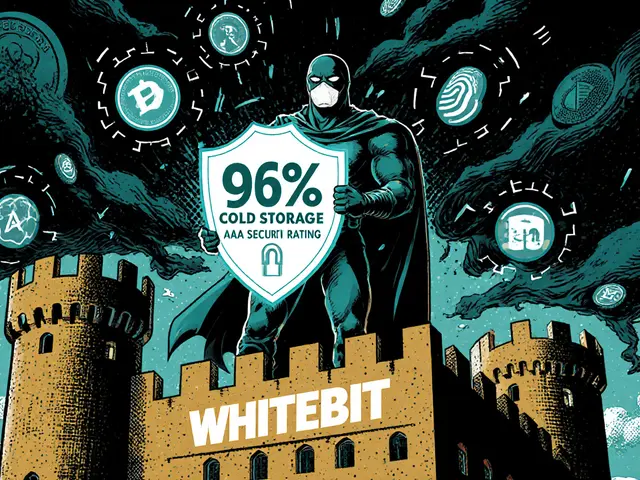
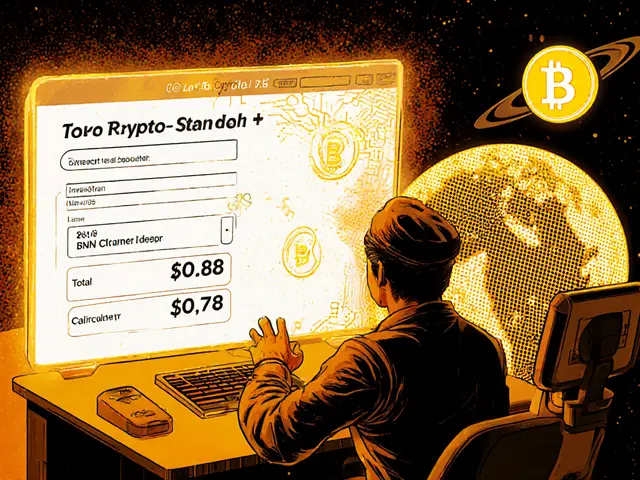

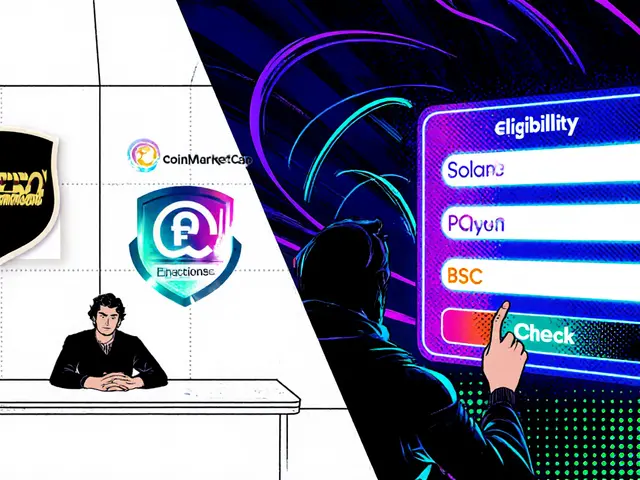

There are 19 Comments
mark gray
OKX's fee structure looks pretty decent overall.
Alie Thompson
When we examine the broader ecosystem, it becomes clear that the relentless pursuit of lower fees can erode the very foundations of trader responsibility, because the temptation to trade excessively without regard for sound risk management grows ever stronger. The moral obligation of an exchange is not merely to shave a fraction of a percent off a transaction, but to cultivate an environment where users are encouraged to act with prudence and foresight. By offering sub‑0.1% taker fees, the platform inadvertently fuels a culture of perpetual speculation that borders on gambling. Moreover, the promise of a 100% Bitcoin reserve, while reassuring on the surface, must be scrutinized for transparency, as undisclosed custody arrangements could conceal systemic vulnerabilities. The reliance on cold storage for 95% of assets is commendable, yet it does not absolve the operator from the duty of regular, independent audits that are accessible to the public. Users must also weigh the hidden costs of fiat deposits, which carry a 1.5‑2% markup-a price that can stealthily diminish the net returns of even the most disciplined investor. In addition, the aggressive marketing of high‑leverage futures, up to 100×, raises ethical questions about exposing retail participants to catastrophic losses. The existence of a $700 million risk fund is a safety net, but it should not be viewed as a license to indulge in reckless product design. It is incumbent upon the community to demand clearer disclosures regarding how that fund is allocated and under what circumstances it may be depleted. Transparency regarding the exchange’s regulatory licenses across various jurisdictions is another pillar of trust, yet the patchwork of approvals can create confusion about user protections. The fact that OKX is barred in major economies such as the United States and Japan should serve as a warning sign, highlighting the regulatory gaps that still persist. Users should not be lulled into complacency by sleek mobile app interfaces; aesthetic appeal does not substitute for robust consumer safeguards. The platform’s demo accounts are useful teaching tools, but they may also give a false sense of security if the transition to live trading is not accompanied by thorough education on margin calls and liquidation risks. Ultimately, the ethical assessment of OKX hinges on whether it prioritizes short‑term fee competition over long‑term user well‑being. A responsible exchange would balance competitive pricing with stringent risk controls, transparent governance, and unwavering commitment to user education. Until such a balance is demonstrably achieved, traders ought to approach the platform with measured caution and an informed perspective.
Samuel Wilson
The fee schedule presented is clear and aligns with industry standards, which should reassure traders seeking cost‑effective execution. It is also noteworthy that the tiered maker‑taker model provides tangible incentives for high‑volume participants.
From a risk management standpoint, the cold‑storage ratio and the disclosed $700 million risk fund are positive indicators of capital adequacy. However, traders should remain vigilant regarding the occasional deposit delays mentioned.
Rae Harris
Honestly, the whole “low‑fee” hype feels like a marketing gimmick when you consider the hidden fiat markup and the limited regulatory protection.
Sure, the app looks slick, but a truly competitive platform would ditch the 0.03% futures taker fee in favour of a more transparent pricing model.
Danny Locher
Looks like OKX has put a lot of effort into making the platform user‑friendly, especially with that demo mode for newbies.
Having a wide range of products can help diversify strategies without constantly switching exchanges.
The 4.5‑star mobile rating shows they’re listening to feedback, which is encouraging.
Overall, it feels like a solid option for both beginners and seasoned traders.
Emily Pelton
While I appreciate the comprehensive feature set, it’s hard to ignore the fact that support response times can be painfully slow, which is unacceptable for active traders, especially during volatile market conditions; the platform should prioritize real‑time assistance, otherwise the user experience suffers significantly, and that’s a major drawback that needs immediate attention.
Gaurav Gautam
Hey everyone, just wanted to add that the DeFi hub can be a game‑changer if you’re looking to earn passive yields without leaving the exchange.
Staking and liquidity mining options are competitive, and the APY rates can beat many traditional savings accounts.
Make sure you understand the lock‑up periods and any potential smart‑contract risks before diving in.
Overall, it’s a nice addition to the already robust product lineup.
Good luck and happy trading!
Cody Harrington
The DeFi options look promising, but I’d advise a cautious approach.
Only allocate what you can afford to lose.
Chris Hayes
OKX’s fee advantage is clear, yet the lack of solid consumer protection in key markets raises some eyebrows.
Their Bitcoin reserve claim sounds good, but independent verification is essential.
Also, the occasional deposit lag could be a hassle for day traders relying on swift capital movement.
Overall, weigh the low fees against these operational quirks before committing large sums.
victor white
Ever wonder why the biggest exchanges keep hiding the true size of their insurance funds? It’s almost as if they’re protecting a secret agenda.
Maybe the risk fund is just a smokescreen to lull users into a false sense of security.
Stay vigilant, folks.
Fiona Chow
Oh great, another exchange bragging about “100% BTC reserve.” Because that’s never been a red flag before.
Sure, the mobile app is shiny, but I’d rather trust a platform with real regulatory oversight.
Just sayin’.
Rebecca Stowe
Even if the reserve claim is questionable, the low fee structure still offers value for many traders.
It’s worth a try if you keep risk management in mind.
Aditya Raj Gontia
Fees are alright, but the UI feels cluttered with too many jargon‑laden tabs.
Could use a cleaner layout.
kishan kumar
One might contemplate the ontological implications of “trust” in a digital ledger; is trust an algorithmic construct or a phenomenological experience? 🤔
In any case, the discourse surrounding reserve proofs demands rigorous epistemic standards.
Let us not be swayed by surface‑level assurances.
Anthony R
OKX’s fee model, while competitive, presents a paradox: lower fees may attract higher volume, which in turn could increase systemic risk, especially if the risk fund is inadequately provisioned, and the platform’s global licensing does not uniformly guarantee consumer safeguards, meaning users should conduct thorough due diligence before committing capital.
Kyle Hidding
The platform’s performance metrics are inflated; the real issue lies in the opaque order‑book depth during peak volatility.
Traders get slippage they weren’t warned about.
Andrea Tan
Hey folks, just wanted to say the community vibe here is pretty welcoming.
If you have questions about the fee calculator, feel free to ask – happy to help!
Let’s keep the discussion friendly and informative.
sandi khardani
While the fee calculator is a neat tool, the reality is that many users ignore the fine print and end up paying more than they anticipate.
It’s frustrating to see platforms hide additional costs behind seemingly low headline rates.
Furthermore, the lack of real‑time support can exacerbate these issues during high‑volume periods.
Transparency should be a priority, not an afterthought.
Without clear communication, trust erodes quickly.
In short, use the calculator, but double‑check the actual transaction receipts.
Donald Barrett
Your so‑called “risk fund” is just a paper tiger, and the whole fee‑saving gimmick is a distraction from the platform’s inherent security flaws.
Write a comment
Your email address will not be published. Required fields are marked *